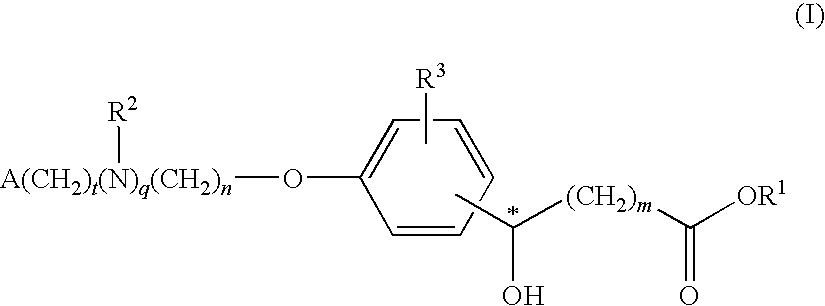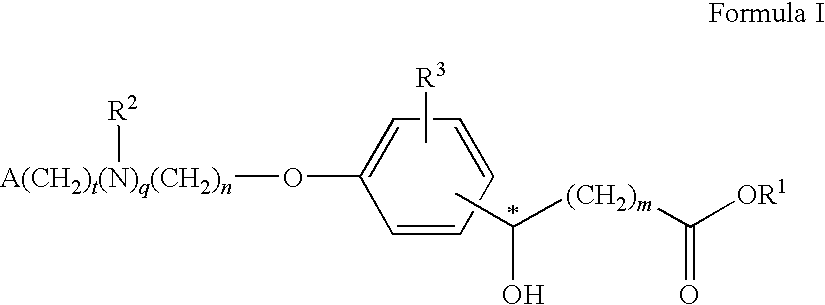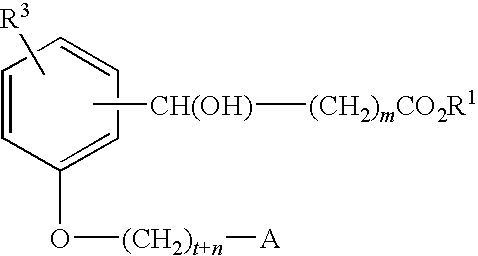Compounds for the treatment of metabolic disorders
a metabolic disorder and compound technology, applied in the field of compound therapy for metabolic disorders, can solve the problems of diabetes mellitus being a major cause of morbidity and mortality, debilitating complications, and prone to coronary artery diseas
- Summary
- Abstract
- Description
- Claims
- Application Information
AI Technical Summary
Benefits of technology
Problems solved by technology
Method used
Image
Examples
synthesis examples
CHEMICAL SYNTHESIS EXAMPLES
Example 1
4-(3-(2,6-Dimethylbenzyloxy)-phenyl)-4(R)-hydroxybutanoic acid
[0240]
Step A: Preparation of 4-(3-(2,6-Dimethylbenzyloxy)-phenyl)-4(R)-hydroxybutanoic acid
[0241]To a stirred solution of 4-(3-(2,6-Dimethylbenzyloxy)phenyl)-4-oxobutyric acid (WO 02 / 100341, 3 g, 9.6 mmol) in methanol (64 ml) was added cerium chloride (3.55 g, 14.4 mmol). The reaction mixture was stirred for 10 minutes at room temperature, cooled to 0° C., and NaBH4 (0.400 g, 10.6 mmol) was added. The stirring continued at 0° C. for 4 hours, and the reaction was quenched with few drops of 50% aqueous acetic acid. Water (60 ml) and chloroform (60 ml) were added, and the reaction mixture was extracted with chloroform (3×25 ml). The organic layer was washed with water (2×) and brine (2×). The combined organic layer was dried over Na2SO4, filtered, concentrated and purified by flash column chromatography using chloroform:methanol (95:5 spiked with acetic acid) to give the title compound as ...
example 2
Antidiabetic Effects of Compound CR in db / db mice—4 Weeks
[0244]Db / db mice have a defect in leptin signaling, leading to hyperphagia, obesity and diabetes. Moreover, unlike ob / ob mice on a C57BL / 6J background, db / db mice on a C57BLKS background undergo failure of their insulin-producing pancreatic islet cells, resulting in progression from hyperinsulinemia (associated with peripheral insulin resistance) to hypoinsulinemic diabetes.
[0245]Male obese (db / db homozygote) C57BL / Ksola mice approximately 8 weeks of age, were obtained from Jackson Labs (Bar Harbor, Me.) and randomly assigned into groups of 5-7 animals such that the body weights (40-45 g) and serum glucose levels (≧300 mg / dl in fed state) were similar between groups; male lean (db / +heterozygote) mice served as cohort controls. A minimum of 7 days was allowed for adaptation after arrival. All animals were maintained under controlled temperature (23° C.), relative humidity (50±5%) and light (7:00-19:00), and allowed free access ...
example 3
Antidiabetic Effects of Compound CR in db / db Mice—2 Weeks
[0250]The same procedure as Example 2 was followed. After 2 weeks of daily oral dosing, both Compound BI and Compound CR elicited a significant reduction in blood glucose (Table III).
[0251]Both compounds markedly reduce triglycerides; however at 2 weeks BI and not CR caused a decrease in free fatty acids (Table IV) as described below. (Compound CR did result in a decrease in free fatty acids at 4 weeks as described above in Example 2.)
[0252]
TABLE IIIThe effects of Compounds BI and CR ina db / db mouse model of type I diabetesGroupsGlucose mg / dLGlucose (% of Control)Vehicle (Control)752.9 ± 46.0 100 ± 6 BI - 100 mg / kg317.4 ± 48.0* 42 ± 6*CR - 100 mg / kg263.2 ± 59.0*35 ± 8*p
[0253]
TABLE IVEffect of Compounds BI and CR on plasma serum glucose,triglycerides, and free fatty acids in db / db miceFree FattyGroupGlucose ± SEMTriglycerides ± SEMAcids ± SEMLean212.6 ± 15.396.4 ± 6.41417.2 ± 54.3Vehicle752.9 ± 46.0388.0 ± 50.71245.9 ± 71.5BI3...
PUM
| Property | Measurement | Unit |
|---|---|---|
| temperatures | aaaaa | aaaaa |
| temperatures | aaaaa | aaaaa |
| temperatures | aaaaa | aaaaa |
Abstract
Description
Claims
Application Information
 Login to View More
Login to View More - R&D
- Intellectual Property
- Life Sciences
- Materials
- Tech Scout
- Unparalleled Data Quality
- Higher Quality Content
- 60% Fewer Hallucinations
Browse by: Latest US Patents, China's latest patents, Technical Efficacy Thesaurus, Application Domain, Technology Topic, Popular Technical Reports.
© 2025 PatSnap. All rights reserved.Legal|Privacy policy|Modern Slavery Act Transparency Statement|Sitemap|About US| Contact US: help@patsnap.com



